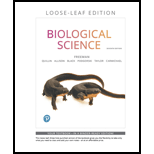
Concept explainers
Introduction:
The reproduction in which the offspring arises from a single organism and genes of only one parent are inherited is called asexual reproduction. The fusion of gametes, changes in the chromosomes, and crossing over are not involved in asexual reproduction.
Answer to Problem 1TYK
Correct answer:
The term parthenogenesis refers to a mode of asexual reproduction, which involves the development of the offspring from unfertilized eggs.
Explanation of Solution
Explanation/Justification for the correct statement:
Option (a) is given as parthenogenesis. The reproduction process where the offspring develops from an ovum without fertilization is called as parthenogenesis. It is the process where offsprings are generated by mitosis, or by meiosis, or by the fusion of two of the products of meiosis. Parthenogenesis occurs in a wide diversity of lineages, including certain invertebrates, fishes, lizards, snakes, and birds. This process usually is observed in some invertebrates, fishes, lizards, snakes, birds, and plants. It is a form of asexual reproduction. The embryos develop without fertilization. Hence, Option (a) is correct.
Explanation for incorrect answers:
Option (b) is given as budding. Budding is also a type of asexual reproduction. The new organism develops from a bud or an outgrowth with the help of cell division. The yeast cells also produce a small bulb-like structure called the bud. So, it is incorrect.
Option (c) is given as regeneration. The process of restoration, renewal, and growth is called regeneration. The process of regeneration is used in cells, organisms, genomes, and others. In some animals, some parts of the body can be regenerated. So, it is incorrect.
Option (d) is given as fission. The fission is the process of division of a single cell or an entity, which generates two or more parts. These parts develop into separate entities independent of each other. Most of the cells undergo fission. A single-celled organism such as Paramecium and Amoeba undergo binary fission. So, it is incorrect.
Hence, options (b), (c), and (d) are incorrect.
The type of reproduction, in which the offspring develops from the unfertilized eggs, is called parthenogenesis.
Want to see more full solutions like this?
Chapter 47 Solutions
Biological Science, Loose-leaf Edition (7th Edition)
- Molecular Biology You discover a disease causing mutation (indicated by the arrow) that alters splicing of its mRNA. This mutation (a base substitution in the splicing sequence) eliminates a 3’ splice site resulting in the inclusion of the second intron (I2) in the final mRNA. We are going to pretend that this intron is short having only 15 nucleotides (most introns are much longer so this is just to make things simple) with the following sequence shown below in bold. The ( ) indicate the reading frames in the exons; the included intron 2 sequences are in bold. A. Would you expected this change to be harmful? ExplainB. If you were to do gene therapy to fix this problem, briefly explain what type of gene therapy youwould use to correct this. Please help. Thank youarrow_forwardMolecular Biology Question Please help. Thank you Explain what is meant by the term “defective virus.” Explain how a defective virus is able to replicate.arrow_forwardMolecular Biology Explain why changing the codon GGG to GGA should not be harmful. Please help . Thank youarrow_forward
- Stage Percent Time in Hours Interphase .60 14.4 Prophase .20 4.8 Metaphase .10 2.4 Anaphase .06 1.44 Telophase .03 .72 Cytukinesis .01 .24 Can you summarize the results in the chart and explain which phases are faster and why the slower ones are slow?arrow_forwardCan you circle a cell in the different stages of mitosis? 1.prophase 2.metaphase 3.anaphase 4.telophase 5.cytokinesisarrow_forwardWhich microbe does not live part of its lifecycle outside humans? A. Toxoplasma gondii B. Cytomegalovirus C. Francisella tularensis D. Plasmodium falciparum explain your answer thoroughly.arrow_forward
- Select all of the following that the ablation (knockout) or ectopoic expression (gain of function) of Hox can contribute to. Another set of wings in the fruit fly, duplication of fingernails, ectopic ears in mice, excess feathers in duck/quail chimeras, and homeosis of segment 2 to jaw in Hox2a mutantsarrow_forwardSelect all of the following that changes in the MC1R gene can lead to: Changes in spots/stripes in lizards, changes in coat coloration in mice, ectopic ear formation in Siberian hamsters, and red hair in humansarrow_forwardPleiotropic genes are genes that (blank) Cause a swapping of organs/structures, are the result of duplicated sets of chromosomes, never produce protein products, and have more than one purpose/functionarrow_forward
- A loss of function mutation in Pitx1 enhancers can cause (blank) Removal of Pitx1 exons and growth of ectopic hindlimbs, growth of extra ectopic forelimbs, loss of forelimb specification and development, and loss of hindlimb specification and developmentarrow_forwardHox1a most likely contributes to (blank) patterning in the developing embryo? Ventral, posterior, limb or anteriorarrow_forwardSelect all of the following that can help establish Hox gene expression boundaries (things that affect Hox and not things that Hox affects). Retinoic acid, anterior/posterior axis, fibroblast growth factors, vagal neural crest, and enhancersarrow_forward
 Concepts of BiologyBiologyISBN:9781938168116Author:Samantha Fowler, Rebecca Roush, James WisePublisher:OpenStax College
Concepts of BiologyBiologyISBN:9781938168116Author:Samantha Fowler, Rebecca Roush, James WisePublisher:OpenStax College
 Comprehensive Medical Assisting: Administrative a...NursingISBN:9781305964792Author:Wilburta Q. Lindh, Carol D. Tamparo, Barbara M. Dahl, Julie Morris, Cindy CorreaPublisher:Cengage LearningEssentials of Pharmacology for Health ProfessionsNursingISBN:9781305441620Author:WOODROWPublisher:Cengage
Comprehensive Medical Assisting: Administrative a...NursingISBN:9781305964792Author:Wilburta Q. Lindh, Carol D. Tamparo, Barbara M. Dahl, Julie Morris, Cindy CorreaPublisher:Cengage LearningEssentials of Pharmacology for Health ProfessionsNursingISBN:9781305441620Author:WOODROWPublisher:Cengage





